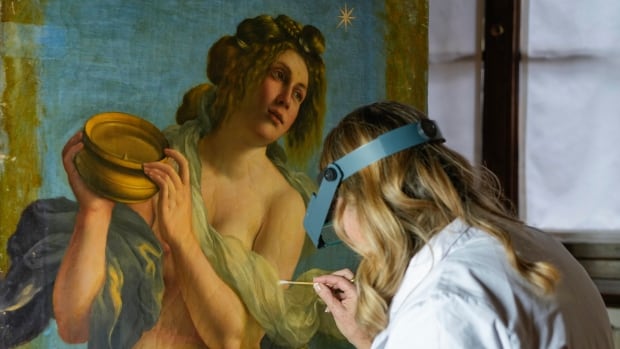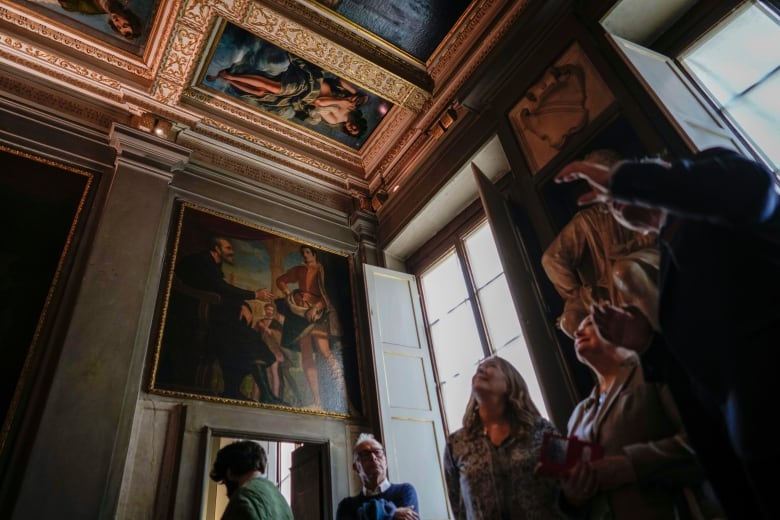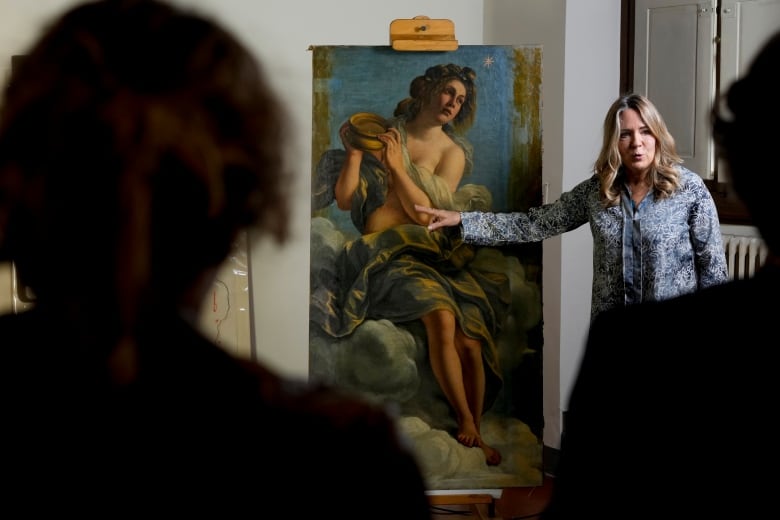
As It Happens6:12This 1616 self-portrait was originally a nude. Then a man had it covered up
For the first time in 342 years, art lovers will get to see Artemisia Gentileschi’s The Allegory of Inclination as the artist intended — with full frontal nudity.
The 1616 painting, believed to be a self-portrait by the trailblazing female Italian artist, originally depicted a nude woman sitting in the clouds.
But 64 years after it was painted, its inheritor hired an artist to add a strategically placed veil to the artwork “to protect the decorum of his wife and children,” Linda Falcone, co-ordinator of the Artemisia Up Close project, told As It Happens host Nil Köksal.
“It was actually to protect a woman’s propriety, funnily enough,” Falcone said. “But censorship was common in the 1600s, and before that as well.”
Now, a team of art restorers is using modern technology to digitally recreate the original, uncensored painting at the Casa Buonarroti museum in Florence, Italy.
Michelangelo’s descendants
Both the original painting, and the cover-up, were commissioned by descendants of the famous renaissance artist Michelangelo.
Michelangelo Buonarroti the Younger, the famed artist’s great-nephew, was one of Gentileschi’s greatest patrons. He commissioned The Allegory of Inclination as part of a series of works on display in his home that paid tribute to his great-uncle’s artistic values, Falcone said.
“Artemisia is painting the inclination to produce art — the drive, the creative drive to produce art,” Falcone said. “Essentially, she’s painting this allegorical figure, this nude that’s now veiled.”

Gentileschi was 22 when she painted The Allegory of Inclination. Widely believed to be a self-portrait, it features a nude woman holding a compass and gazing at the sky, the North star visible above her.
“Women at this time were not considered capable of artistic production. They weren’t [considered] capable of great works. The fact that Michelangelo the Younger wants her to produce that specific value is really important, because he’s actually saying, ‘Yes, women can produce art. They do have the drive to produce art,'” Falcone said.
“And that’s why she wanted to be connected to the painting.”
Michelangelo the Younger hung the painting in a gilded frame on the ceiling of his home, which later became the Casa Buonarotti museum.
That’s where it has remained ever since, except in 1680, when Michelangelo the Younger’s nephew, Leonardo Buonarroti, hired Baldassarre Franceschini to paint on a flowing piece of pale blue fabric to cover the nudity, and again now for its restoration.
Why not restore the original?
The work is now at ground level in the museum, so the public can see it up close for the first time — and even watch the restoration live — until April 23.
“The fact that the public can participate in this process is of fundamental importance,” Falcone said. “What really matters is the conversation, the conversation that art lovers are having, up close and personal with the painting.”

Lead conservator Elizabeth Wicks and her team are using ultraviolet light, diagnostic imaging and X-rays to differentiate Gentileschi’s brush strokes from those of the artist that covered the nudity.
A digital image of the original version will be displayed in an exhibition on the project opening in September 2023.
Falcone says they can’t restore the original work for several reasons.
From a practical perspective, the layers of paint have simply become too fused to undo the addition without damaging Gentileschi’s original brushstrokes.
But there’s also historical value, she says, in preserving the censored work.
“That censorship is now part of the painting’s life. It’s a historical addition, let’s say,” she said.
Surviving sexual assault, and the trial that ensued
The process, Falcone said, is revealing more information about Gentileschi’s technique, and offering a rare window into the life and work of a woman who made unprecedented waves in the male-dominated art world.
Gentileschi’s story is one of suffering, survival and success.
Born and raised in Rome, she travelled to Florence shortly after the high-profile trial of her rapist, landscape painter Agostino Tassi.
According to The Associated Press, the then-17-year-old Gentileschi was forced to testify with ropes tied around her fingers that were progressively tightened, supposedly to test her honestly. She was also forced to undergo a physical examination in the courtroom, behind a curtain, to confirm that she was no longer a virgin.
Tassi was convicted and sentenced to eight months in prison.
“Somebody else would have been crushed by this experience,” lead restoration artist Wicks said. “But Artemisia bounces back. She comes up to Florence. She gets this wonderful commission to paint a full-length nude figure for the ceiling of Casa Buonarroti. So, I think she’s showing people, ‘This is what I can do.'”
For decades, Gentileschi’s sexual assault overshadowed discussions of her work, according to a May 2022 exploration of her legacy on CBC Radio’s Ideas. But in recent decades, there has been a growing appreciation in the art history world for her achievements.
She produced works centred on “famous women, mythological women, [and] strong women,” Falcone said. She became the first woman to attend the Academy of the Arts of Drawing in Florence. And she rubbed shoulders with famous Italians, including the legendary astronomer Galileo.
“She was so many things. Perhaps a feminist. Perhaps a realist. A humanist, definitely. But she knew how to market herself and she knew how to connect herself to the canvas,” Falcone said. “She was really good at being at the centre of attention, on and off canvas.”
Support is available for anyone who has been sexually assaulted. You can access crisis lines and local support services through this Government of Canada website or the Ending Violence Association of Canada database. If you’re in immediate danger or fear for your safety or that of others around you, please call 911.